With summer fast approaching, islanders and tourists will venture out into the more untamed parts of the archipelago. Hiding among the brush, grass and trees are ticks, waiting to pounce.
An Orcas mother contacted the San Juan County Environmental Health department last week after her young child was bitten by a tick. She sent the arachnid to an independent lab that she said confirmed the tick was infected with Lyme disease.
According to county environmental health manager Kyle Dodd, the child is showing no symptoms. Watch the Journal for a discussion with the mother.
History
An epidemic in the northeast United States, Lyme disease isn’t common in the San Juan Islands, but that’s not to say it cannot happen here.
“It’s not all that common in our state even though we certainly do have the deer tick that carries it, and there is evidence around the state that the Borrelia i’ve changed this from berrillia bacteria is present,” Dodd said. “A full investigation would start if a human came down and was infected. That’s when we would start our investigation and follow up.”
According to the Washington State Department of Health, there were 39 cases of Lyme disease in Washington state in 2017. The agency’s website added that most reported Lyme patients had traveled to and were bitten by a tick in the Northeast United States. Fewer than three cases each year are from ticks in the state.
Lyme is transmitted through the bite of a tick infected with a bacterium called Borrelia burgdorferi, which is contracted from the tick from biting infected animals, like deer and mice.
It was named in 1975 when children in Lyme, Connecticut, became sick and were misdiagnosed with rheumatoid arthritis. Seven years later researchers discovered tick bites were the cause of the illness.
According to the Centers for Disease Control, “Lyme disease is the most commonly reported vector-borne illness in the United States. … However, researchers say it does not occur nationwide and is concentrated heavily in the northeast and upper Midwest.”
Symptoms
The CDC states the symptoms of untreated Lyme disease include severe headaches, neck stiffness, rashes, arthritis with severe joint pain and swelling, particularly in the knees and other large joints; facial palsy, which is a loss of muscle tone or droop on one or both sides of the face; intermittent pain in bones, joints, muscles and tendons; heart palpitations or irregular heartbeat; episodes of dizziness or shortness of breath; inflammation of the brain and spinal cord; nerve pain; shooting pain, numbness or tingling in the hands or feet; and problems with short-term memory.
Treatment
While the CDC states that 70 to 80 percent of infected persons will experience an erythema migrans rash, the International Lyme Disease and Associated Diseases Society states that only 20 percent of Lyme-positive patients see the telltale bull’s-eye rash. What makes the topic of diagnosis more perplexing is that testing for the disease often provides false negatives. Doctors recommend several tests be done in tandem for accuracy.
According to Mayo Clinic, because ticks are in contact with many other animals, they may be spreading multiple diseases with one bite. The other complication is that Lyme can often act like other diseases.
Studies show that 10 to 20 percent of people with Lyme who are treated with antibiotics have symptoms of fatigue, pain or joint and muscle aches. In some cases, these can last for more than six months.
Prevention
The best way to avoid the disease is to steer clear of tick-infested areas like leaf piles, long grass, stumps or fallen logs. Dodd suggested that any time a person is outside, they should wear long pants; wear long-sleeved shirts; tuck shirts into pants and pants into socks; wear light-colored clothing; and to don no open-toed shoes. He added that when returning indoors, people should check their bodies immediately.
The Lyme Disease Association recommends that if you do find a tick, remove it with tweezers as straight out of the skin as possible; do not twist it. Save the tick, and call a doctor.
Independent testing
The CDC does not recommend that people have ticks tested through commercial laboratories as those facilities are not required to have high standards of quality control like clinical diagnostic laboratories are. Additionally, the CDC says that a positive result from an independent laboratory should not be used for diagnostic purposes.
Results supporting or denying the presence of Lyme in the tick can be misleading as there is a potential that the disease was not transmitted to the human from the infected tick or that the person was not bitten by another tick if the one tested is not infected.
Cali Bagby contributed to this article.



